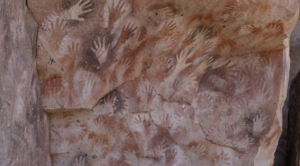
A screenshot from ‘Nomad,’ distributed by Music Box Films.
The film Nomad: In the Footsteps of Bruce Chatwin was shown at Tribeca and Telluride, and on the BBC, in 2019, but it is just now available in the US, on several platforms. The film is a documentary on the writer, who died in 1989, by his friend Werner Herzog.
“A few times in his life, and in my life, our paths had intersected,” Herzog says. “And there were points, landscapes, we had explored independently, unbeknownst to each other, sometimes with many years in-between.”
The documentary takes us to some of those points, such as Australia, and to Chile and Wales. We meet mutual acquaintances, including Chatwin’s widow, Elizabeth, in Greece, and his biographer, Nicholas Shakespeare, at Bodleian Library, which holds Chatwin’s papers and dozens of notebooks.
As the title indicates, the documentary is not a full biography of Chatwin, but a memoir, focused on mutual ideas the two men held about walking, strangeness, and obsession.
“The world reveals itself to him who travels on foot,” Herzog said in one of his books, which Chatwin used to carry. Chatwin wrote of Herzog, “He was also the one person with whom I could have a one-to-one conversation on what I would call the sacramental aspect of walking.”
The two met in Australia in 1983, when Herzog was working on his film Where the Green Ants Dream, and Chatwin was doing research for The Songlines. Their instant friendship brought “a marathon” of intense talk, Herzog says, which continued in various forms for the rest of Chatwin’s life. Herzog’s 1987 film Cobra Verde was adapted from Chatwin’s book The Viceroy of Ouidah, and Chatwin, who was then terminally ill from AIDs, went to Ghana for a couple of weeks to watch it being filmed.
Herzog later went to see Chatwin on his deathbed and describes him as “a skeleton and eyes, glowing out of a skeleton.”
“’Werner, I’m dying,’” Herzog recalls Chatwin saying when he arrived. “And I looked at him and said, ‘Bruce, I can see that.’”
Chatwin begged Herzog to help him die—”Help me, help me, help me”—because Elizabeth was Catholic and would not countenance suicide. Instead of giving him pills to overdose, Herzog showed him his hallucinatory film Herdsmen of the Sun, about Saharan nomads, as Chatwin lapsed in and out of delirium.
“I’ve got to be on the road again!” Chatwin shouted.
This segment is the only time I can remember Herzog crying on film.
Chatwin left Herzog the leather rucksack he carried, walking, for “thousands” of miles. It plays a role in the documentary and in the making of Herzog’s fiction film Scream of Stone, which was infused with the death of his friend and “carries a mood of precariousness,” Herzog says. “Everything can end in sudden death.”
What interests me most about Herzog’s many short or long nonfiction films is the sense that his narrative forms are coming apart—with mastery, not from the decadent urge to be different or quirky. With many writers I admire, story seems to be one of the last things to go, and it may be the most profound and inevitable move, even as it feels precarious. Both Chatwin and Herzog work emotionally more than logically and take up whatever subjects interest them. Both can be episodic. Both value mystery, the unknowable. Something is out there, and they each walk out to meet it, alone.
Nomad risks being storyless. Or maybe what it shows is personal enough that some may feel left out. (A friend made a good case that the film suggests, in its intense private grief, that the men were lovers.)
Nicholas Shakespeare makes the argument that a wonder cabinet Chatwin marveled at and dreamed over in childhood can be seen as the start of his “stories of how he got there,” a lifetime working method that itself risks formlessness.
“Chatwin was a writer like no other,” Herzog says. “He would craft mythical tales into voyages of the mind. In this respect, we found out we were kindred spirits, he as a writer, I as a filmmaker. In this film here I will follow a similar erratic quest for wild characters, strange dreamers, and big ideas about the nature of human existence. These were the themes Chatwin was obsessed with.”
Herzog captures the emotion of these obsessions. In one segment he shows us cave art thousands of years old, including dozens of handprints on the rocks. There are more than seem possible. In his strangled accent he says in voiceover, “The hands of these long-gone people are the direct imprint of their presence, almost forensic evidence. But the longer you LOOK, the more unreal, the more mysterious they become.” The soundtrack is all wailing and cellos, which turns minor-key. The camera floats around loosely. The effect is hallucinatory.
Similarly, Herzog delights in Chatwin’s last handwritten notes, in a notebook now in the Bodleian archives.
“The very last lines he ever wrote,” Herzog exults to Shakespeare, who looks a little lost. “Christ wore a seamless robe.”
“End of story,” Herzog says authoritatively. “The book is closed.”
Nomad closes with the idea that Chatwin knew he was terminally ill as he was writing Songlines, and that “the final pages of his book carry the mood of a journey coming to an end,” Herzog says. Another Chatwin friend says, “[Bruce] talks about the idea that when close to death some aboriginal people take a long journey back to the place of their conception. […] And I think it was a message that held a lot of value for Bruce at that point. I think he was looking for a way to die.”
When Herzog, who is 78, looks into the nomadic life of his friend Bruce Chatwin, he is really looking at their commonalities, which is to say at himself.
Read more by John Griswold, here.
